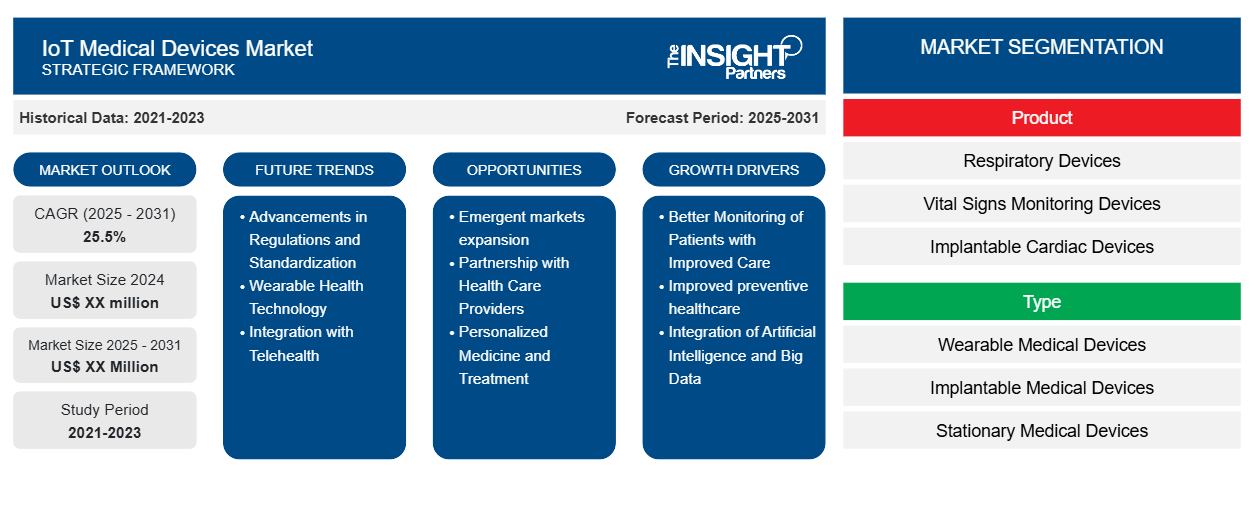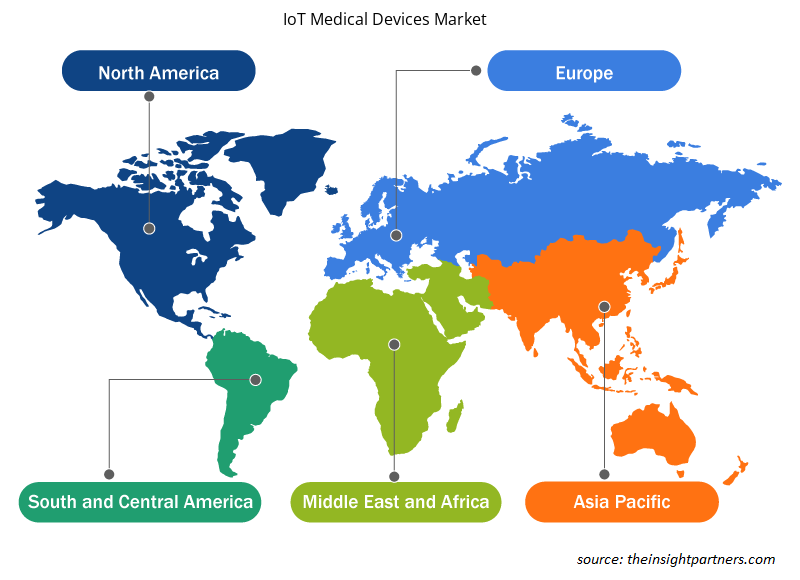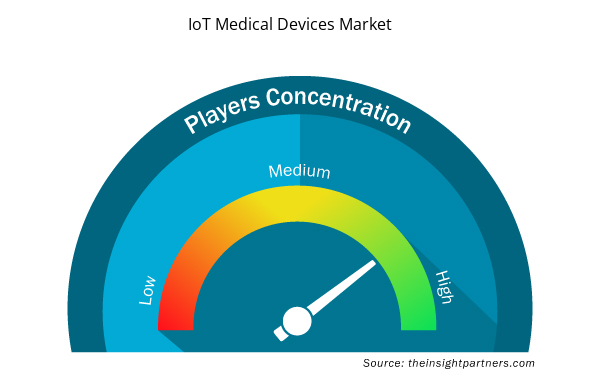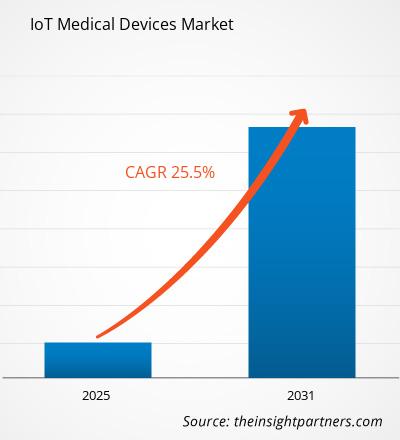The IoT Medical Devices Market is expected to register a CAGR of 25.5% from 2025 to 2031, with a market size expanding from US$ XX million in 2024 to US$ XX Million by 2031.
The report is segmented by Product (Respiratory Devices, Vital Signs Monitoring Devices, Implantable Cardiac Devices, Patient Monitors, Anesthesia Machines, Ventilators, Imaging Systems, Infusion Pumps, Other Products); Type (Wearable Medical Devices, Implantable Medical Devices, Stationary Medical Devices, Other IoT Medical Devices); Technology (Bluetooth, Wi-Fi, Zigbee, Other Connectivity Technologies); End User (Hospitals and Clinics, Nursing Homes, Assisted Living Facilities and Long-Term Care Centers, Home Care Settings, Other End Users). The global analysis is further broken-down at regional level and major countries. The Report Offers the Value in USD for the above analysis and segments.
Purpose of the Report
The report IoT Medical Devices Market by The Insight Partners aims to describe the present landscape and future growth, top driving factors, challenges, and opportunities. This will provide insights to various business stakeholders, such as:
- Technology Providers/Manufacturers: To understand the evolving market dynamics and know the potential growth opportunities, enabling them to make informed strategic decisions.
- Investors: To conduct a comprehensive trend analysis regarding the market growth rate, market financial projections, and opportunities that exist across the value chain.
- Regulatory bodies: To regulate policies and police activities in the market with the aim of minimizing abuse, preserving investor trust and confidence, and upholding the integrity and stability of the market.
IoT Medical Devices Market Segmentation
Product
- Respiratory Devices
- Vital Signs Monitoring Devices
- Implantable Cardiac Devices
- Patient Monitors
- Anesthesia Machines
- Ventilators
- Imaging Systems
- Infusion Pumps
- Other Products
Type
- Wearable Medical Devices
- Implantable Medical Devices
- Stationary Medical Devices
- Other IoT Medical Devices
Technology
- Bluetooth
- Wi-Fi
- Zigbee
- Other Connectivity Technologies
End User
- Hospitals and Clinics
- Nursing Homes
- Assisted Living Facilities and Long-Term Care Centers
- Home Care Settings
- Other End Users
Customize This Report To Suit Your Requirement
You will get customization on any report - free of charge - including parts of this report, or country-level analysis, Excel Data pack, as well as avail great offers and discounts for start-ups & universities
IoT Medical Devices Market: Strategic Insights

- Get Top Key Market Trends of this report.This FREE sample will include data analysis, ranging from market trends to estimates and forecasts.
IoT Medical Devices Market Growth Drivers
- Better Monitoring of Patients with Improved Care: With the growing prevalence of chronic diseases, there is a need to monitor a patient at times. IoT medical devices can provide information in real-time and can track patients remotely, thus allowing healthcare providers to track the health condition of patients with minimal interference. Such proactive monitoring contributes to improved outcomes in patients while reducing readmission of patients to hospitals. Such effective management of chronic conditions, therefore, supplements the market size of IoT medical devices.
- Improved preventive healthcare: IoT is at the heart of the evolution of healthcare devices from reactive to proactive care. Such devices play a crucial role in the early diagnosis of health conditions; subsequently, continued analysis of data will propel patients and providers to well-informed decisions. The rise in wellness and prevention hence pushes the uptake of IoT solutions, furthering market growth as patients seek new ways to monitor their health.
- Integration of Artificial Intelligence and Big Data: The IoT medical device thus revolutionizes the delivery of health by embedding artificial intelligence and big data analytics in healthcare. These technologies force their ways to enhance functions into delivering predictive analytics and more informed decisions, thereby freeing vast amounts of health data made possible through AI-driven IoT devices, which provide actionable insights of the patient for personalized care, optimize treatment plans, and streamline health operations.
IoT Medical Devices Market Future Trends
- Advancements in Regulations and Standardization: Advances in the medical devices of the IoT have led to the regulatory bodies of respective companies framing frameworks that will assure the safety and efficacy of such devices. All these have worked toward standardization, increasing the confidence of the consumers and driving research within the industry. Established norms for the evaluation of devices and data security make the entry process much easier for new technologies entering this market, allowing them to thrive and improve their patient care outcomes.
- Wearable Health Technology: Health technology wearables are now rapidly gaining acceptance in the list of medical devices and other smartwatches and fitness trackers because of their advanced capabilities. These can monitor quite basic life signs like heartbeats, activities, and even sleep patterns for users, thus helping them receive essential health information. An increase in consumer interest in self-management of health and wellness is a big market trend that is likely to lead to a rise in innovation and wearables adoption, hence integration with telehealth.
- Integration with Telehealth: The connectivity of medical appliances in the IoT with the telehealth platform has led to a change in the nature of care as it has made remote consulting and monitoring services possible. It will increase access to health for underserved patient groups. This sharing of real-time data between the patient and the healthcare provider with various other stakeholders leads to patient engagement, cost reduction in operational activities, and timely intervention- all factors that increase further growth in the market for IoT medical devices.
IoT Medical Devices Market Opportunities
- Emergent markets expansion: The emerging markets promise promise for the IoT medical devices market, as healthcare infrastructure is developing rapidly in most regions. So, smarter penetration and internet access will facilitate the use of connected devices. As these regions are asking for affordable solutions in the healthcare sector, IoT devices can provide cheap monitoring and management options that will reap a much bigger market for companies expanding their scope.
- Partnership with Health Care Providers: Developing IoT medical devices may become a possibility by having strategic partnerships with the health sector and different technology companies. It could be at the intersection of efforts on individual aspects that result in more productive operations by bringing together all the elements of healthcare through IoT, such as data analytics and telehealth services, among many more.
- Personalized Medicine and Treatment: IoT medical devices promise to tap into the revolution of personalized medicine. Being in a position to tap health data in real-time, the devices can then be fashioned to add value to individual patient treatment, thus enhancing the effectiveness and adherence to treatment. The technology enhances outcomes in health and makes companies poised on the growth trajectory of personalized healthcare.
IoT Medical Devices Market Regional Insights
The regional trends and factors influencing the IoT Medical Devices Market throughout the forecast period have been thoroughly explained by the analysts at Insight Partners. This section also discusses IoT Medical Devices Market segments and geography across North America, Europe, Asia Pacific, Middle East and Africa, and South and Central America.

- Get the Regional Specific Data for IoT Medical Devices Market
IoT Medical Devices Market Report Scope
| Report Attribute | Details |
|---|---|
| Market size in 2024 | US$ XX million |
| Market Size by 2031 | US$ XX Million |
| Global CAGR (2025 - 2031) | 25.5% |
| Historical Data | 2021-2023 |
| Forecast period | 2025-2031 |
| Segments Covered |
By Product
|
| Regions and Countries Covered | North America
|
| Market leaders and key company profiles |
IoT Medical Devices Market Players Density: Understanding Its Impact on Business Dynamics
The IoT Medical Devices Market market is growing rapidly, driven by increasing end-user demand due to factors such as evolving consumer preferences, technological advancements, and greater awareness of the product's benefits. As demand rises, businesses are expanding their offerings, innovating to meet consumer needs, and capitalizing on emerging trends, which further fuels market growth.
Market players density refers to the distribution of firms or companies operating within a particular market or industry. It indicates how many competitors (market players) are present in a given market space relative to its size or total market value.
Major Companies operating in the IoT Medical Devices Market are:
- AliveCor, Inc.
- GENERAL ELECTRIC COMPANY
- IBM Corporation
- Koninklijke Philips N. V.
- LINK LABS
Disclaimer: The companies listed above are not ranked in any particular order.

- Get the IoT Medical Devices Market top key players overview
Key Selling Points
- Comprehensive Coverage: The report comprehensively covers the analysis of products, services, types, and end users of the IoT Medical Devices Market, providing a holistic landscape.
- Expert Analysis: The report is compiled based on the in-depth understanding of industry experts and analysts.
- Up-to-date Information: The report assures business relevance due to its coverage of recent information and data trends.
- Customization Options: This report can be customized to cater to specific client requirements and suit the business strategies aptly.
The research report on the IoT Medical Devices Market can, therefore, help spearhead the trail of decoding and understanding the industry scenario and growth prospects. Although there can be a few valid concerns, the overall benefits of this report tend to outweigh the disadvantages.
- Historical Analysis (2 Years), Base Year, Forecast (7 Years) with CAGR
- PEST and SWOT Analysis
- Market Size Value / Volume - Global, Regional, Country
- Industry and Competitive Landscape
- Excel Dataset



Report Coverage
Revenue forecast, Company Analysis, Industry landscape, Growth factors, and Trends

Segment Covered
This text is related
to segments covered.

Regional Scope
North America, Europe, Asia Pacific, Middle East & Africa, South & Central America

Country Scope
This text is related
to country scope.
Frequently Asked Questions
AliveCor, Inc., GENERAL ELECTRIC COMPANY, IBM Corporation, Koninklijke Philips N.V. accounting for higesh market shares and are some of the major players operating in the market
The Patient Monitors segment accounts for highest revenue in product the IoT Medical Devices Market in 2023
The IoT Medical Devices Market is estimated to witness a CAGR of 25.5% from 2023 to 2031
Asia Pacific region dominated the IoT Medical Devices Market in 2023
North America region dominated the IoT Medical Devices Market in 2023
The major factors driving the IoT Medical Devices Market are:
1. Better Monitoring of Patients with Improved Care
2. Improved preventive healthcare
3. Integration of Artificial Intelligence and Big Data
Trends and growth analysis reports related to Technology, Media and Telecommunications : READ MORE..
1. AliveCor, Inc.
2. GENERAL ELECTRIC COMPANY
3. IBM Corporation
4. Koninklijke Philips N. V.
5. LINK LABS
6. Medtronic
7. OMRON Corporation
8. Siemens Product Lifecycle Management Software Inc.
9. STANLEY Healthcare
10. Welch Allyn

 Get Free Sample For
Get Free Sample For